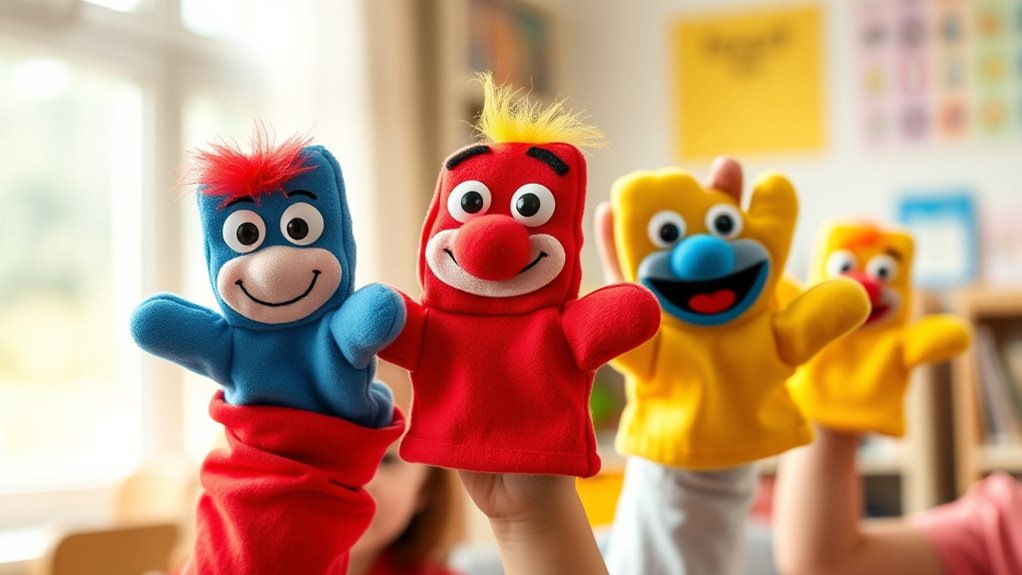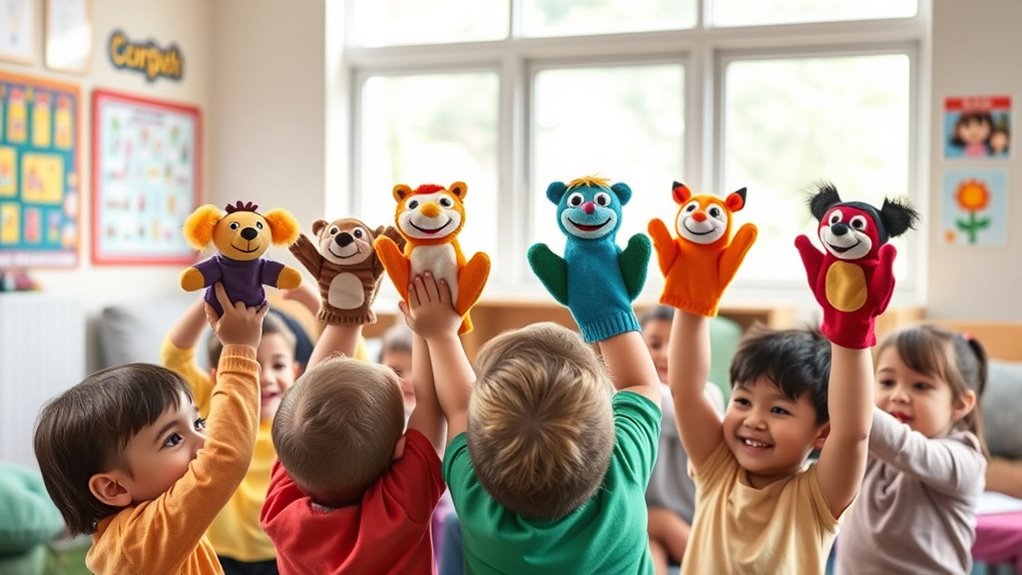Use puppet play to teach social-emotional skills by creating scenarios where puppets express different emotions like happiness, sadness, or anger. You can craft stories that encourage children to identify feelings, practice empathy, and develop communication skills. Incorporate situations where puppets face dilemmas or misunderstandings, prompting kids to suggest calming or problem-solving strategies. Keep the play fun and engaging—if you continue exploring, you’ll find more ideas to make social-emotional learning effective and enjoyable.
Key Takeaways
- Use puppet characters to depict and identify a range of emotions, enhancing emotional vocabulary and recognition skills.
- Create stories where puppets face social dilemmas to foster empathy and perspective-taking.
- Incorporate puppet dialogues to practice active listening, communication, and conflict resolution.
- Encourage children to suggest coping strategies for puppets experiencing strong feelings like sadness or anger.
- Utilize puppet play routines to make social-emotional skills engaging, relatable, and fun for children.

Are you looking for fun and engaging ways to bring your puppet collection to life? Puppet play offers a fantastic opportunity to foster essential social‑emotional skills, especially emotion regulation and empathy development. When you use puppets in your activities, you create a safe space for children to explore their feelings, practice self-control, and understand others’ perspectives. This approach transforms learning into an interactive, playful experience that resonates deeply with young minds.
Start by creating scenarios where children can practice recognizing and naming their emotions through puppet characters. For example, you might have a puppet that feels sad because it lost its toy or angry after a disagreement. As children watch or participate, they learn to identify these emotions, which is the first step toward emotion regulation. Encourage them to suggest ways the puppet might calm down or feel better, guiding them to develop coping strategies. This method helps children understand that emotions are normal but can be managed with the right techniques. It also reinforces emotional vocabulary, making it easier for them to communicate their feelings clearly. Recognizing the importance of effective communication can significantly enhance their social interactions.
Create puppet scenarios to help children recognize and name their emotions effectively.
Puppet play is particularly effective for empathy development because it invites children to step into someone else’s shoes. You can create stories where puppets face dilemmas or misunderstandings, prompting children to think about how the puppet might feel in that situation. For instance, a puppet might be left out of a game, and children can discuss how the puppet feels and what they could do to make it feel included. By engaging in these narratives, children learn to recognize others’ emotions and respond compassionately. They begin to see situations from different perspectives, which nurtures empathy and social understanding.
As you guide puppet interactions, emphasize the importance of listening and responding thoughtfully. Ask questions like, “How do you think the puppet feels right now?” or “What could the puppet do to feel better?” This encourages children to consider others’ emotions and think critically about their reactions. Using puppets also allows children to experiment with conflict resolution and problem-solving in a non-threatening environment. They can practice expressing their own feelings and understanding those of others, fostering emotional intelligence that will serve them well in real-life social situations.
Incorporating puppet play into your routine not only makes learning about emotions fun but also provides practical tools for children to regulate their feelings and develop empathy. By making these skills interactive and relatable through puppets, you help children build a compassionate, emotionally aware mindset. It’s a simple yet powerful way to turn social‑emotional learning into a lively, meaningful experience for everyone involved.
Frequently Asked Questions
How Can Puppet Play Improve Emotional Regulation Skills?
Puppet play improves emotional regulation skills by encouraging you to express emotions through characters, fostering emotional expression and self-awareness. As you manipulate puppets, you can explore different feelings, helping you recognize and understand your own emotions better. This playful activity also provides a safe space to practice calming strategies or problem-solving, boosting your ability to manage emotions effectively in real-life situations.
What Age Groups Benefit Most From Puppet-Based SEL Activities?
You’ll find that early childhood and elementary students benefit most from puppet-based SEL activities. These age groups are naturally expressive and curious, making puppets an engaging tool to explore emotions, empathy, and social skills. By using puppets, you help young children develop emotional regulation and communication in a playful, approachable way. This method boosts their confidence, encourages participation, and fosters a supportive environment for social-emotional growth.
How Do I Select Appropriate Puppets for Diverse Emotional Scenarios?
To select appropriate puppets for diverse emotional scenarios, focus on cultural representation and puppet customization. Choose puppets that reflect different backgrounds, experiences, and emotions to foster inclusivity and relatability. Customize puppets if needed, adding features or accessories that express specific feelings. This approach helps children see themselves in the puppets, encouraging empathy and understanding while making social-emotional learning more engaging and meaningful.
Can Puppet Play Be Integrated Into Virtual or Remote Learning?
Yes, puppet play can be seamlessly integrated into virtual learning by using online storytelling and virtual engagement tools. You can encourage students to create their own puppets and participate in interactive storytelling sessions via video calls. This approach fosters social-emotional skills, boosts participation, and makes learning more engaging. Incorporating puppets into your virtual lessons helps children express emotions and practice empathy, even from a distance.
What Are Some Tips for Encouraging Shy Children to Participate?
Remember, “A journey of a thousand miles begins with a single step.” To encourage shy children, create trust-building activities like gentle puppet interactions and small group roles. Use puppets to model social skill development, making participation feel safe and fun. Gradually invite them to share, praising efforts to boost confidence. By fostering a supportive environment, you help shy children open up and thrive in social settings.
Conclusion
Incorporating puppet play into your social-emotional learning activities can considerably boost children’s empathy and communication skills. Did you know that children who participate in expressive play show a 30% increase in emotional understanding? By using puppets, you create a safe space for kids to explore feelings and practice problem-solving. So, give puppet play a try—it’s a fun, effective way to help children develop essential social skills that last a lifetime.










